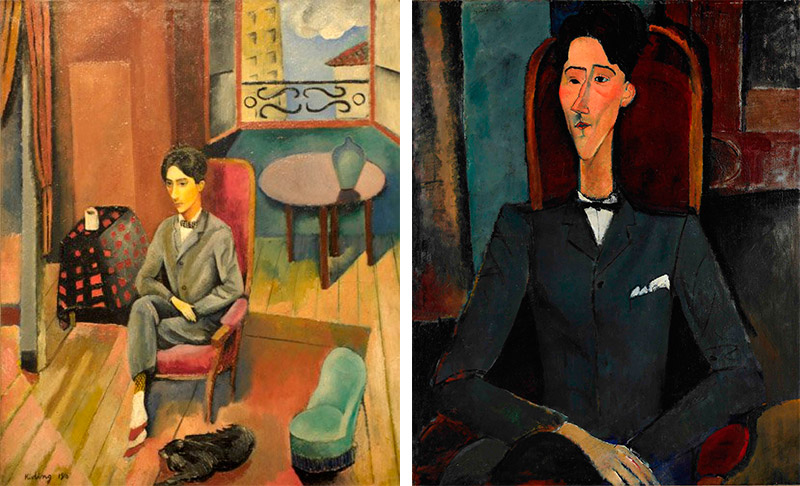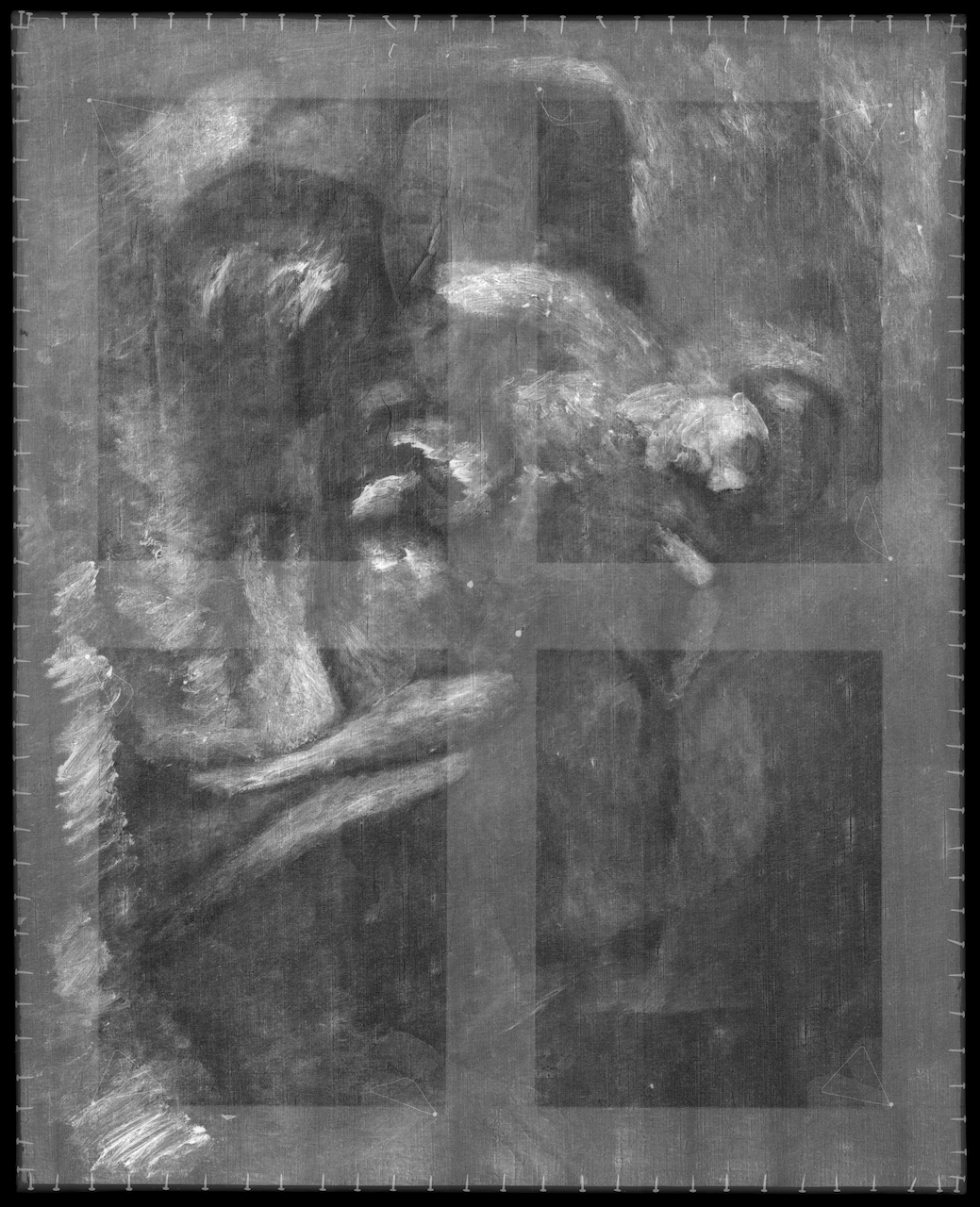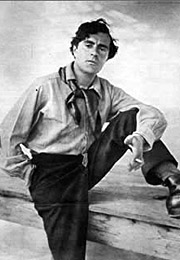


Oil on canvas
100.4 x 81.3 cm. (39 1/2 x 32 in.)
frame: 113.7 x 94.6 x 7.6 cm. (44 3/4 x 37 1/4 in.)
L.1988.62.18
Signed upper left: Modigliani
Acquired from the artist by Jean Cocteau, Paris, ca. 1917; sold by Moise Kisling to the owner of Café Rotonde, ca. 1917. De Caves, Paris. Zborowski, Paris. E[mile] Khoury (Khouri), Paris. Paul Guillaume (1891–1934), Paris, by 1926; by descent to his widow Domenica Guillaume (later Walter). Billy Rose (1899–1966), New York, by 1944; sold to George Gard “Buddy” De Sylva (1895–1950), Los Angeles; by descent to the estate of George Gard De Sylva; [James Vigeveno Galleries, Los Angeles]; [Pierre F. Nesi, Paris]; sold to Henry Pearlman, by Mar. 1951; Henry and Rose Pearlman Foundation, after 1974.
In the spring of 1916, Pablo Picasso brought the poet Jean Cocteau to meet the artists and poets who habitually gathered at Moïse Kisling’s Montparnasse studio. The Right Bank poet apparently irritated the group of Left Bank friends with his pretentions: the poet Pierre Reverdy recounted later that Cocteau talked incessantly, his voice like the rain beating on the roof, while everyone ignored him.
Both Modigliani and Kisling painted Cocteau, and Modigliani’s devastating portrait captures the poet’s vanity. Cocteau paid for the portrait by Modigliani, but, claiming that it would not fit in a taxi, left it behind and never sent for it. At this time in his life, Cocteau was proud of his long, straight nose, which is shown here with a bump, so his pride may have been wounded. Cocteau later wrote, “It does not look like me, but it does look like Modigliani, which is better.”
Portrait of Jean Cocteau by Moise Kisling alongside Modigliani’s:

X-ray of Modigliani’s “Jean Cocteau” showing an unidentified painting underneath:

The portrait of Jean Cocteau by Modigliani seems to have traveled and been exhibited widely and been in various collections before it finally settled in mine. I know the sitter…
The portrait of Jean Cocteau by Modigliani seems to have traveled and been exhibited widely and been in various collections before it finally settled in mine. I know the sitter hasn’t yet visited the United States and has therefore not seen the portrait for a good many years. Recently Cocteau wrote an article in the French weekly magazine Arts along the following lines:
When Modigliani did my portrait, he worked in the same workshop as Kisling on rue Joseph-Bara. I do not know what has become of the portrait by Kisling where one can see Picasso having lunch in the background, and wearing a black checked shirt.
The portrait by Modigliani was on a large canvas. He sold it to me for 5 francs. I had not, alas, enough money to pay for the car which would enable me to take the portrait to my house. Kisling owed 11 francs to the Cafe Rotonde. He proposed to give the proprietor this portrait in exchange. The proprietor accepted, and the canvas commenced a voyage which was terminated by a sale of 17 million francs in America.
I am not telling you this story to complain, but to tell you that we could have become wealthy, and that we did not become so.
Alfred Barr told me he thought this painting and one in the Museum’s collection were the two finest works of Modigliani.
I have a letter from Jean Cocteau stating that, “It does not look like me, but it does look like Modigliani, which is better.”

Amedeo Modigliani (1884-1920)
Modigliani lived a much-fabled life among the international avant-garde circles in early 20th-century Paris. Although he died at the age of thirty-five, Modigliani was a prolific artist, best known for his uniquely stylized paintings and drawings of friends, lovers, fellow artists, and literary figures. As a group, these works form an articulate portrait of the avant-garde centered around Montmartre at the time.
Modigliani was born in Livorno, Italy, to a middle-class Jewish family. He suffered serious illness during his youth, contracting pleurisy, which developed into tuberculosis. From his early teens he resolved to become an artist, and in 1898 he began to study with local plein air painter Guglielmo Micheli, who stressed working directly from nature. Modigliani was exposed to a wide variety of Italian art over the course of travels through his home country and received formal training in Florence (1902), followed by Venice. In January 1906, Modigliani moved to Paris, where he settled, first in Montmartre and later in Montparnasse, and attended the Académie Colarossi. Among the international coterie of young artists, Modigliani stood out in particular for his combination of personal elegance, intellectual prowess, and frail health. He experimented with different styles and influences, including the work of Henri de Toulouse-Lautrec, Picasso’s blue period, and the late portraits of Paul Cézanne.
Modigliani first turned to sculpture in 1902, and the medium became his primary focus from 1909 to 1914. He was inspired in part by meeting Constantin Brancusi, whose stylized sculptural forms, devotion to direct carving, and fierce independence all had an impact on Modigliani. He created a body of about twenty-five carved stone sculptures that focused on abstracted female heads, which vividly melded the influence of African sculpture with strains of Egyptian, Cycladic, Greek, Romanesque, and Gothic styles. Conceiving of these works as a series, he exhibited seven heads together in 1912 at the Salon d’Automne, under the title Têtes, ensemble décoratif.
Apparently due to health concerns and other practicalities, Modigliani ceased work on sculpture around 1914 and turned his focus to drawing and painting, in which the influence of his sculptural work remained indelible. He made a series of overtly erotic contemporary nudes, although portraiture was his dominant subject. Modigliani’s portraits combine abstraction and elements of caricature; his stylized faces and bodies often are surprisingly revealing in their degree of penetrating observation and psychological subtleties. His portraits captured many leading figures in the artistic and literary avant-garde, among them Jacques Lipchitz, Pablo Picasso, Diego Rivera, Chaïm Soutine, Jean Cocteau, and Max Jacob. Modigliani’s life was cut short by tubercular meningitis, and his demise was hastened by his abundant use of drugs and alcohol.